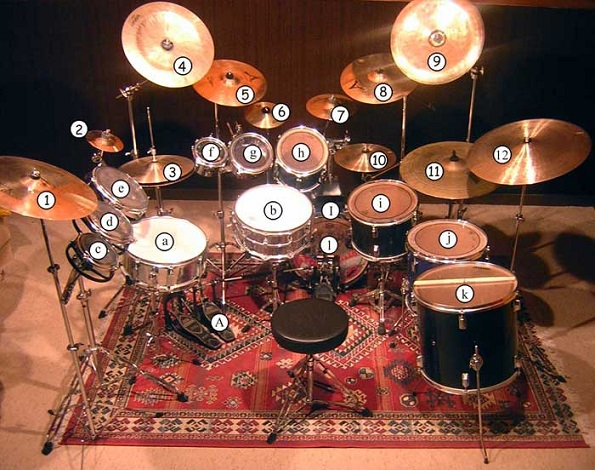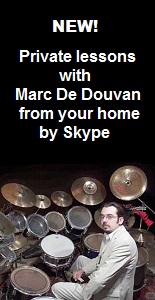
 : : : Lessons : : Conceiving your drum set : Set 9 : Metal, progressive rock
: : : Lessons : : Conceiving your drum set : Set 9 : Metal, progressive rock
Set 9 : Metal, Progressive Rock
(12 drums, 14 cymbals, 1 cowbell, 1 double pedal)

- Description:
-
- 1 : Crash 18''
- 2 : Splash 6''
- 3: Hi-hat 14''
- 4: China 17''
- 5 : Crash 16''
- 6 : Splash 8''
- 7 : Splash 10''
- 8 : Crash 17''
- 9: Chinese 18''
- 10: Suspended hi-hat 12''
- 11 : Leopard ride 20''
- 12 : Crash 19''
-
- a: "Piccolo" snare drum 12 x 5''
- b: Snare drum 14 x 6.5''
- c: High rototom 6''
- d: Medium rototom 8''
- e: Low rototom 10''
- f: "Soprano" tom 8''
- g: "Alto" tom 10''
- h: "Tenor" tom 12''
- i: "Baritone" tom 14''
- j: "Piccolo" floor tom 16''
- k: Floor ("bass") tom 18''
- l: Bass Drum 22''
- I: large cowbell
- A: double pedal or double bass drum

This set exceptionally rich is typical of 2000s. Quite a lot of drummers of metal, fusion and progressive rock have adopted it.
We can name Mike Portnoy (Dream Theater), but with a kit that extends further to the right with a second seat (which he calls the "Siamese Monster"), Mike Terrana (Rage, Axel Rudi Pell, Yngwie Malmsteen, Tony Mac Alpine, Kiko Loureiro ) with only two suspended toms and two floor toms on the right, no rototoms but a "gong" bass drum to the extreme right and left, no crash at the extreme left and a floor tom instead of the piccolo snare, the ride and the right hi-hat being inverted, the suspended hi-hat (with a 16 " oversized Chinese as bottom cymbal) being above, at the height of splashes, themselves topped with Greek cymbals ("cup chime") for even drier sound, Thomas Lang (John Wetton) with the addition of a hi-hat including two 8" Greek cymbals ("bells", small and thick) for his right foot, a snare drum and a gong bass drum to the left (sometimes), no rototoms, a jam-block on his left foot (played by a "twin FX" pedal: with two independent beaters like a double pedal but actuated by heel and toe) or a snare drum, a second smaller bass drum and a "tube" drum, and only two suspended toms and two floor toms, one more crash between the others on the right, at the same height, 4 small pierced China (less resonant) specially designed for him ("filter" China) from 8 to 14", under the crashes, at the splashes height, two other crashes instead of Chinese here (just sometimes, knowing that he arranges his cymbals setup quite variably, with sometimes less cymbals) and a higher bass drum on the right of the right foot (sometimes also), Aquiles Priester (Angra) with 2 "giga bell" rides (with a huge dome: "Psychoctopus" model, specially designed for him), to the right as to the left of the 2 hi-hats, for a playing completely ambidextrous) , a floor tom instead of the "piccolo" snare drum, real toms instead of rototoms passing above the hat like in the set 10 (he is a fan of Nicko Mc Brain) and a mini-Chinese (14") above the ride and below the last crash on the right and finally, a very small Chinese like a splash (8 ") designed for him too, to the left of the central splashes, Neil Peart (Rush) with an electronic drum in his back (to play just by making an about-turn on the seat), a floor tom instead of the left snare, shifted to the left, 4 suspended toms including two above the left hi-hat, a stand with 5 cowbells setup in 3 superimposed lines over an electronic slides keyboard ("Malletkat") instead of rototoms and a different setup of cymbals, like ride and suspended hi-hat on the right, reversed, the ride left below, as Mike Terrana do.
Notice the 3 sets of toms aligned in descent (the rototoms having no shell, they are naturally with higher pitch), separated by two pairs of hi-hat cymbals. This gives these cymbals a privileged position which is typical of rock and metal.
Other cymbals are arranged according to three superimposing lines and classified by type (except for the ride, which is below, at the same level as the hi-hats): down below the splashes, then the crashes and finally the Chinese on top. The Higher you go, the more you give emphasis and power, and the less they are accessible (this is quite logical, we must know how to spare our effects and therefore to limit the use of the most powerful instruments). Thomas Lang uses this configuration with superimposing cymbals, to make chords (fast arpeggios) with cymbals by hitting three superimposed cymbals from underneath, in one sweeping stick lifting motion (like a pick on guitar strings ).
The use of two Chinese allows explosive hits with single stroke roll (one for the right hand and one for the left hand) which Mike Terrana is quite fond for their double bass drum finales (probably an idea from Carmine Appice).
Note the two crashes positioned at the ends of the set in order to punctuate descents and ascents of all the drums (therefore in both directions).
Note also the placing of the 3 floor toms (baritone, piccolo bass and bass), the second being slightly staggered offset to reduce the space between the first and the last and thus facilitate arpeggios. Some drummers place even 3 of their toms in an equilateral triangle for the same reason as Ian Paice (Deep Purple), for example.
Finally, see the little splash 6'' to the left of the hi-hat on the left, which is quite rare, for marking accents with a splash by passing on offbeats (left hand) by making a continuous single stroke roll (no crossing of the hands) like Manu Katché do sometimes.
In short, a drumset with a beautiful harmony but careful of the lumbar vertebrae for the twist of spine to catch the instruments to the extreme right or the extreme left. Furthermore, it is almost impossible to play on both ends at the same time, what motivates changes of atmosphere and style (typical of progressive rock).
Terry Bozzio, who owns the richest set in history (with only one seat) uses roughly the same configuration principle, but with more Chinese cymbals specially designed by him ("Radia" model, partially chiseled and tuned) with two pairs of stacked Chinese cymbals (or one Chinese on a crash), per stand, through boom extensions placed on the screw; moreover they are set up like stagered rows to save space (the lowest being the smallest, placed at the extreme right and left, the next cymbal being placed between the two previous Chinese of the preceding stand), no second snare drum but a second row (or third recently) of 8-inch tuned "picolos" toms (designed especially for him) instead (4 or 9), two bass drums driven by double pedal to the left of the left foot and right of the right foot (thanks to the transmission bar), no splash but smaller returned Greek cymbals put on larger separated by a felt washer (Jack DeJohnette has done the same with "flat ride" cymbals below), the ride cymbal is replaced by a Chinese gong (Flat) placed horizontally (played like a ride), 2 hi-hat actioned by transmission bar ("remote", passing under the "piccolos" toms, cymbals being above) on the left (china hat 16" on 18" and 13" "factory metal" (steel cymbal cross cut) on "chopper" (3 layers bronze cut discs)), a third remote hi-hat pedal with Chinese cymbals (16" over 20") positioned above the toms on the right and one or two tiny suspended hi-hat ("mini hi-hats" or "splash-hats" of 6 and 7 or 8 ") in front of the bass drum (instead of the cowbell presented here and on the left of the snare) to not break the progression of the toms (from 14 to 24 toms, including two or three rows of 8-inch toms tuned chromatically placed staggered ("piccolo toms" sometimes without resonance skin and with a very shallow depth shell) to the left and one (then bigger, formerly) or two rows of normal toms 10, 12, 13 and 14 " tuned diatonically on the right and one 8 and two 10 above the snare drum). Recently he added a stand of 13 chromatically tuned Thai gongs and a tam-tam (large Chinese flat gong) on his back. Finally, he has another cable hi-hat for the right foot (formerly), a stand with tambourine with snare for the left foot and a suspended skinless tambourine (and I still probably forget instruments). On the contrary, he does not include any Latin instrument, not even a cowbell, unlike the set that I present after and which I play (to see more detailed explanation with photos of Terry Bozzio's drumsets on his website, click on this following link: http://www.terrybozzio.com/?page_id=20).
Marc De Douvan, march 2006, augmentation and translation in English: march 2015.
© 2005 Marc de Douvan Crédits Mentions légales
